Development of LPFG-Based Seawater Concentration Monitoring Sensors Packaged by BFRP
Abstract
1. Introduction
2. Basic Theory of Long Period Fiber Gratings
3. Sensor Design
4. Sodium Chloride and Calcium Chloride Concentration Measuring Test
4.1. Sodium Chloride Solution Concentration Measurement Test
4.2. Calcium Chloride Solution Concentration Measurement Test
4.3. Real-Time Sodium Chloride Solution Concentration Monitoring Test
5. Conclusions
- (1)
- The temperature coefficient of the sensor in freshwater is about 0.0633 nm/°C;
- (2)
- The LPFG exhibits sensitivity to NaCl and CaCl2 solution concentration changes through three parameters: center wavelength, peak loss at center wavelength, and 3 dB bandwidth. However, only the center wavelength shows a strong linear correlation with concentration variation. The linear coefficients are determined to be −0.160 nm/% for NaCl solution and −0.225 nm/% for CaCl2 solution, respectively.
- (3)
- The developed sensor achieves real-time monitoring of NaCl solution concentration changes with a measurement error of approximately 1.8%, demonstrating good practical applicability.
Author Contributions
Funding
Data Availability Statement
Acknowledgments
Conflicts of Interest
References
- Uchida, H.; Kayukawa, Y.; Maeda, Y. Ultra high-resolution seawater density sensor based on a refractive index measurement using the spectroscopic interference method. Sci. Rep. 2019, 9, 15482. [Google Scholar] [CrossRef]
- Katsumata, K.; Purkey, S.G.; Cowley, R.; Sloyan, B.M.; Diggs, S.C.; Moore, T.S.; Talley, L.D.; Swift, J.H. GO-SHIP easy ocean: Gridded ship-based hydrographic section of temperature, salinity, and dissolved oxygen. Sci. Data 2020, 9, 103. [Google Scholar] [CrossRef] [PubMed]
- Li, Y.; Wu, G.; Song, G.; Lu, S.-H.; Wang, Z.; Sun, H.; Zhang, Y.; Wang, X. Soft, pressure-tolerant, flexible electronic sensors for sensing under harsh environments. ACS Sens. 2022, 7, 2400–2409. [Google Scholar] [CrossRef] [PubMed]
- Dinnat, E.P.; Le Vine, D.M.; Boutin, J.; Meissner, T.; Lagerloef, G. Remote sensing of sea surface salinity: Comparison of satellite and in situ observations and impact of retrieval parameters. Remote Sens. 2019, 11, 750. [Google Scholar] [CrossRef]
- Demir, O.; Johnson, J.T.; Jezek, K.C.; Brogioni, M.; Macelloni, G.; Kaleschke, L.; Brucker, L. Studies of sea-ice thickness and salinity retrieval using 0.5–2 GHz microwave radiometry. IEEE Trans. Geosci. Remote Sens. 2022, 60, 4304412. [Google Scholar] [CrossRef]
- Zhao, J.; Zhao, Y.; Cai, L. Hybrid fiber-optic sensor for seawater temperature and salinity simultaneous measurements. J. Lightwave Technol. 2022, 40, 880–885. [Google Scholar] [CrossRef]
- Meng, Q.; Dong, X.; Ni, K.; Li, Y.; Xu, B. Optical fiber laser salinity sensor based on multimode interference effect. IEEE Sens. J. 2014, 14, 1813–1816. [Google Scholar] [CrossRef]
- Geng, T.; Su, C.; Zhang, S.; Ma, Y. Recent progress in embedded LPFGs. Measurement 2023, 222, 113686. [Google Scholar] [CrossRef]
- Siyu, E.; Zhang, Y.-N.; Han, B.; Zheng, W.; Wu, Q.-L.; Zheng, H.-K. Two-Channel Surface Plasmon Resonance Sensor for Simultaneous Measurement of Seawater Salinity and Temperature. IEEE Trans. Instrum. Meas. 2020, 69, 7191–7199. [Google Scholar] [CrossRef]
- Xue, Y.; Dai, W.; Wang, X.; Li, C.; He, J. Development of OFDR-based Inclination Sensor for Deformation Measurement of Foundation Pile. Measurement 2024, 231, 114618. [Google Scholar] [CrossRef]
- Xue, Y.; He, J.; Zhang, D.; Liu, W. Development of based Intelligent Geotextile and Its Case Study in High-speed Railway Subgrade. Measurement 2023, 214, 112820. [Google Scholar] [CrossRef]
- Liu, B.; He, J.P.; Zhang, S.H. Measurement Improvement of Distributed Optical Fiber Sensor via Lorenz Local Single Peak Fitting Algorithm. Symmetry 2021, 13, 1166. [Google Scholar] [CrossRef]
- Sun, M.Y.; Jiang, H.T.; Shi, B. Development of FBG salinity sensor coated with lamellar polyimide and experimental study on salinity measurement of gravel aquifer. Measurement 2019, 140, 526–537. [Google Scholar] [CrossRef]
- Luo, D.; Ma, J.; Ibrahim, Z.; Ismail, Z. Etched FBG coated with polyimide for simultaneous detection the salinity and temperature. Opt. Commun. 2017, 392, 218–222. [Google Scholar] [CrossRef]
- Qian, Y.; Zhao, Y.; Wu, Q.L.; Yang, Y. Review of salinity measurement technology based on optical fiber sensor. Sens. Actuators B Chem. 2018, 260, 86–105. [Google Scholar] [CrossRef]
- Li, G.C.; Wang, Y.J.; Shi, A.C.; Liu, Y.F.; Li, F. Review of seawater fiber optic salinity sensors based on the refractive index detection principle. Sensors 2023, 23, 2187. [Google Scholar] [CrossRef] [PubMed]
- Tang, F.J.; Na, W.; Lin, Z.B. Simultaneous measurement of early-stage corrosion and strain levels in steel rebars based on LPG-FBG optical fiber sensor. Constr. Build. Mater. 2024, 433, 136771. [Google Scholar] [CrossRef]
- Chen, Y.Z.; Tang, F.J.; Tang, Y.; O’Keefe, M.J.; Chen, G. Mechanism and sensitivity of Fe-C coated long period fiber grating sensors for steel corrosion monitoring of RC structures. Corros. Sci. 2017, 127, 70–81. [Google Scholar] [CrossRef]
- Tang, F.J.; Chen, Y.Z.; Li, Z.C.; Tang, Y.; Chen, G.D. Application of Fe-C coated LPFG sensor for early-stage corrosion monitoring of steel bar in RC structures. Constr. Build. Mater. 2018, 175, 14–25. [Google Scholar] [CrossRef]
- Liu, B.; He, J.P.; Zhang, L.; Tang, J.L.; Zhang, S.; Zhang, S. Pipeline safety monitoring technology based on FBG-ROTDR joint system and its case study of urban drainage pipeline monitoring. Opt. Fiber Technol. 2022, 73, 103044. [Google Scholar] [CrossRef]
- Qi, Y.F.; Jia, C.; Tang, L.; Zhang, X.; Gong, C.; Liu, Y.; Liu, X. Research on temperature and humidity sensing characteristics of cascaded LPFG-FBG. Optik 2019, 188, 19–26. [Google Scholar] [CrossRef]
- Mohamed, O.A.; Al Hawat, W.; Keshawarz, M. Durability and mechanical properties of concrete reinforced with basalt fiber-reinforced polymer (BFRP) bars: Towards sustainable infrastructure. Polymers 2021, 13, 1402. [Google Scholar] [CrossRef]
- Wang, Z.; Zhao, X.L.; Wu, G.; Raman, R.S.; Al-Saadi, S.; Haque, A. Long-term durability of basalt-and glass-fibre reinforced polymer (BFRP/GFRP) bars in seawater and sea sand concrete environment. Constr. Build. Mater. 2017, 139, 467–489. [Google Scholar] [CrossRef]
- Wu, B.; Zhou, Y.; Lu, H.; Huang, Y.; Zhou, Z. Fatigue resistance of a BFRP-encapsulated long-gauge FBG strain sensor under cyclic train loads. KSCE J. Civ. Eng. 2022, 26, 3945–3953. [Google Scholar] [CrossRef]
- Liu, T.; Fu, Y.; Li, K.; Zhou, A.; Qin, R.; Zou, D. Experimental investigation and theoretical analysis of long-term performance for optical fiber Bragg grating-fiber reinforced composite in alkaline concrete environment. Constr. Mater. 2024, 22, e04130. [Google Scholar] [CrossRef]
- Hu, Q.H.; Tian, X.; Zhao, X.F.; Wang, M.; Xi, X.M.; Wang, Z.; Xu, X. Fabrication of cascaded wideband LPFGs by CO2 laser and Raman suppression in a 5 kW one-stage MOPA fiber laser. Opt. Laser Technol. 2022, 150, 107984. [Google Scholar] [CrossRef]
- Zhao, Y.H.; Liu, Y.Q.; Zhou, C.; Guo, Q.; Wang, T. Sensing characteristics of long-period fiber gratings written in thinned cladding fiber. IEEE Sens. J. 2015, 16, 1217–1223. [Google Scholar] [CrossRef]
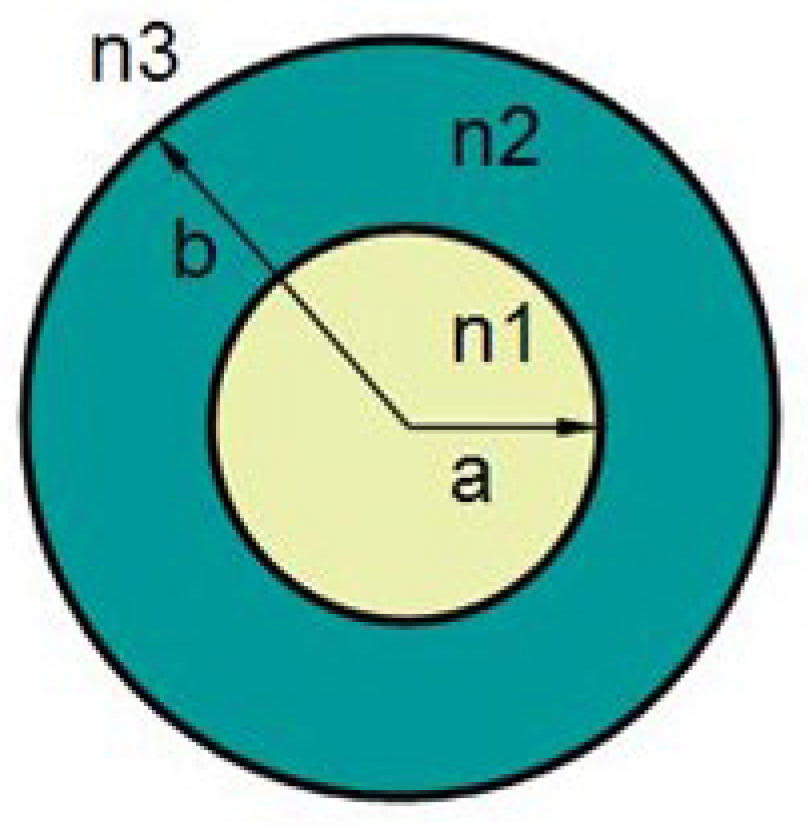

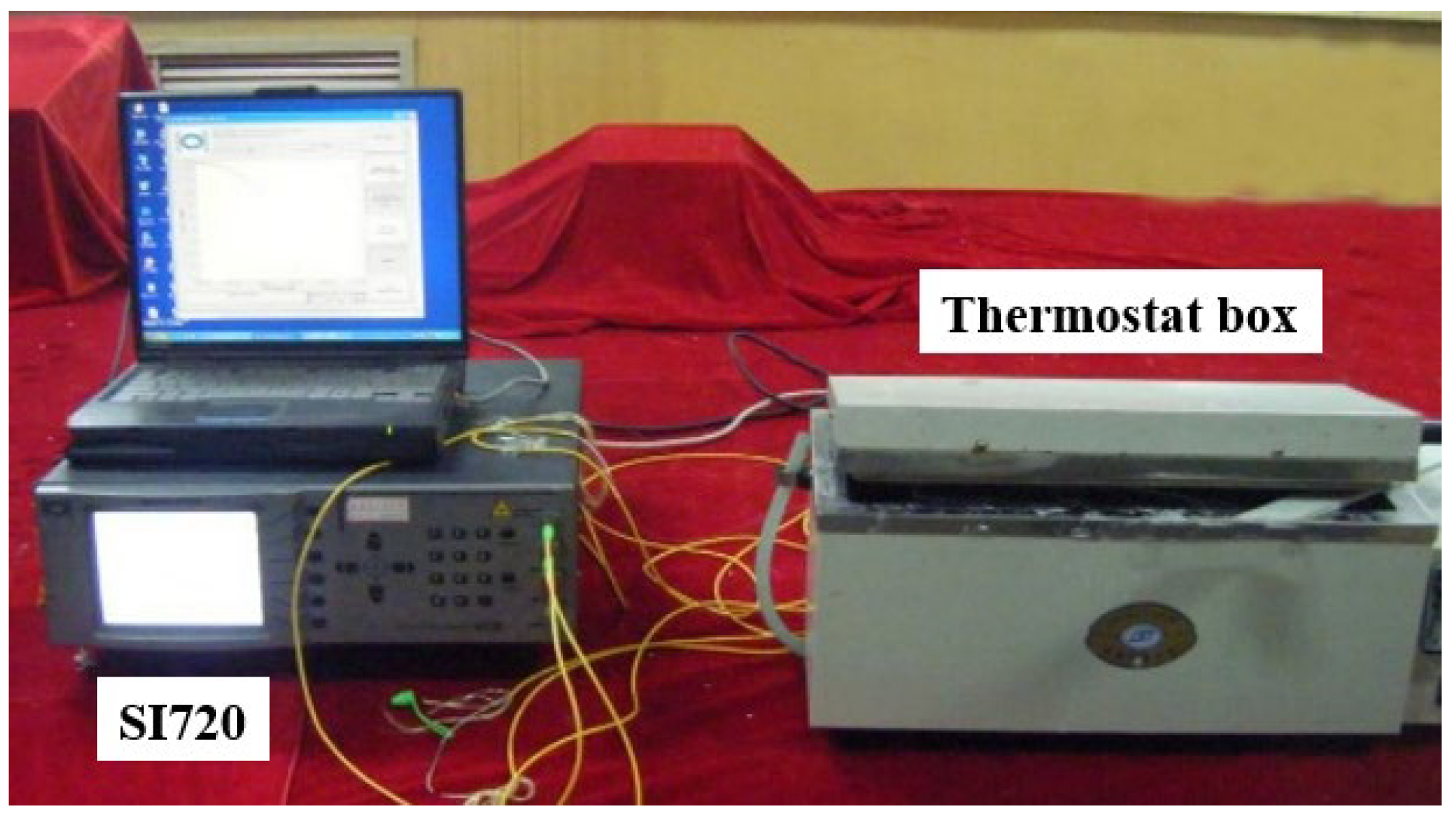
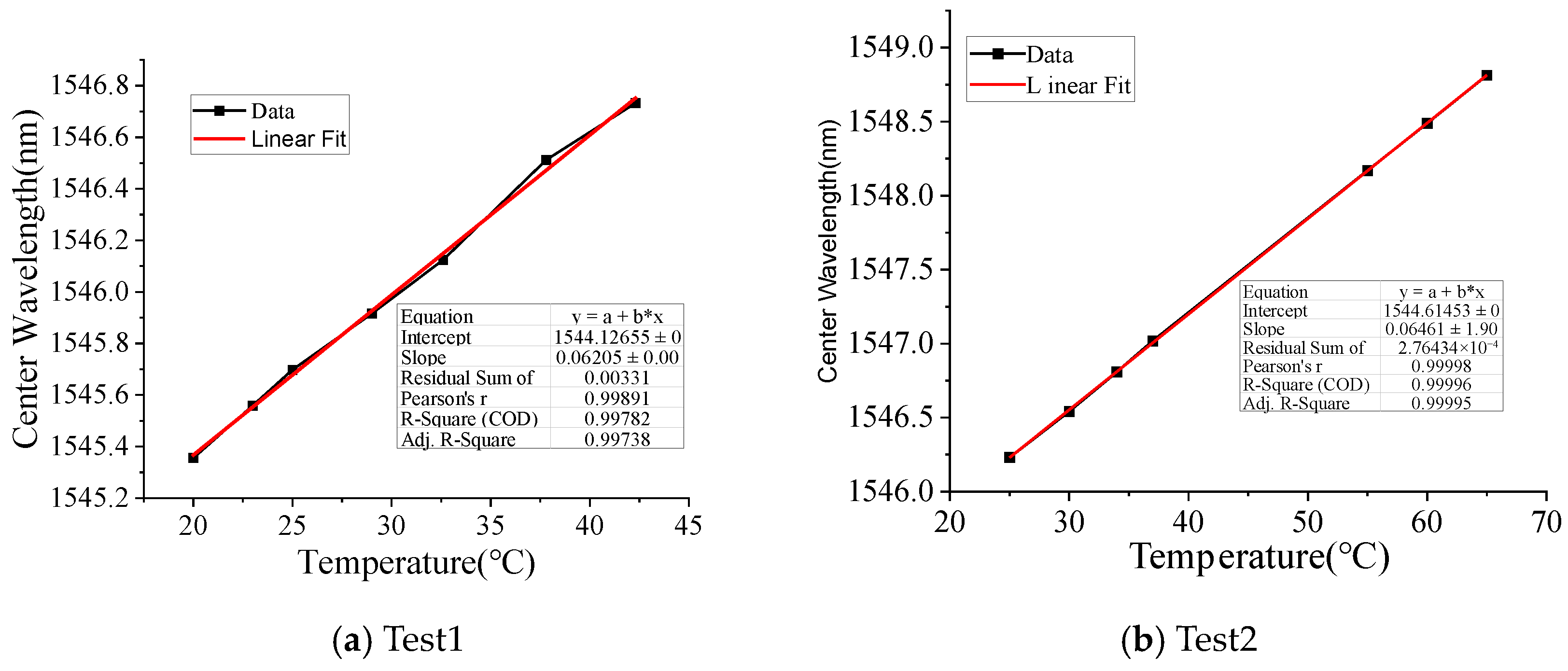

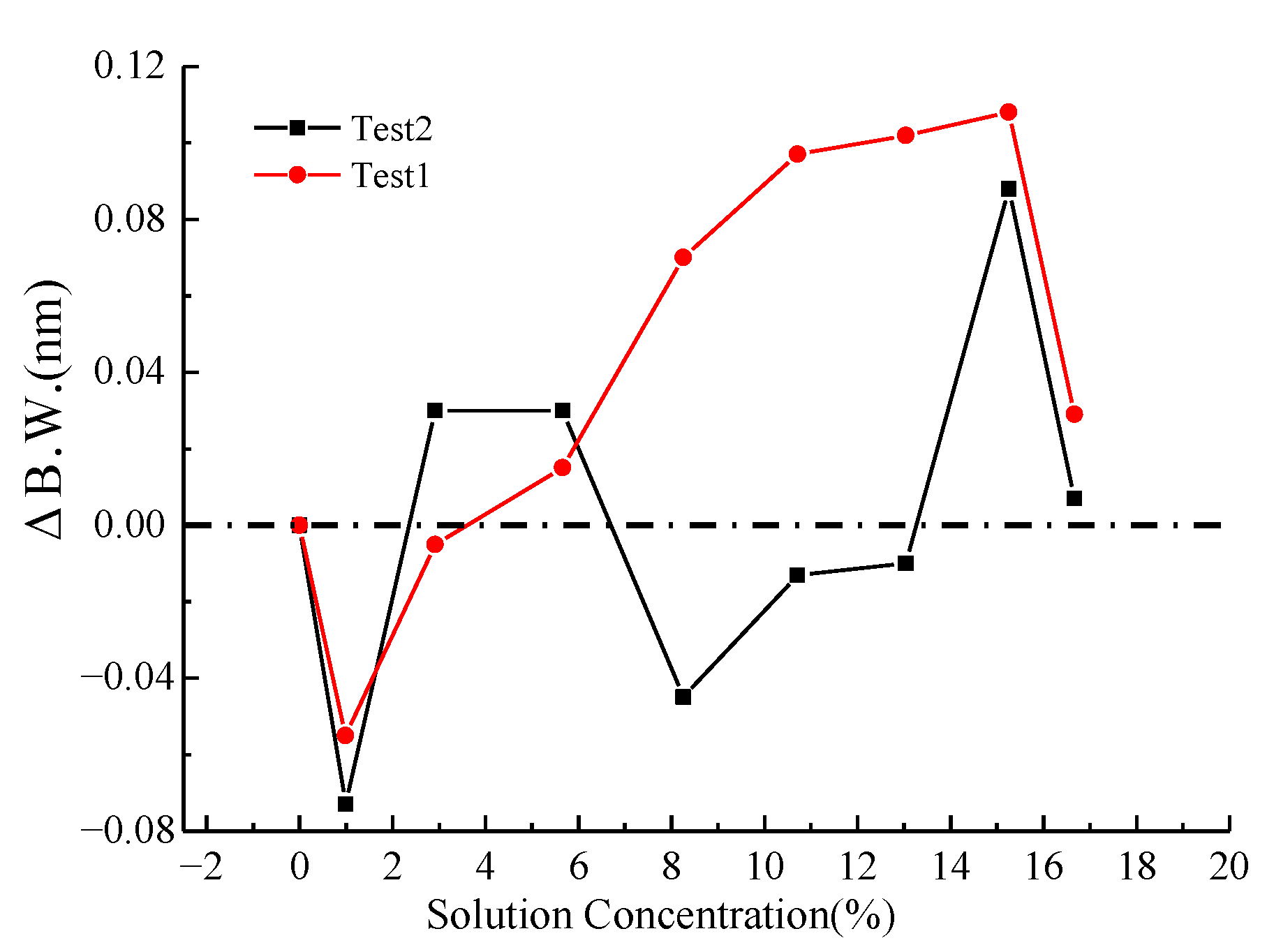
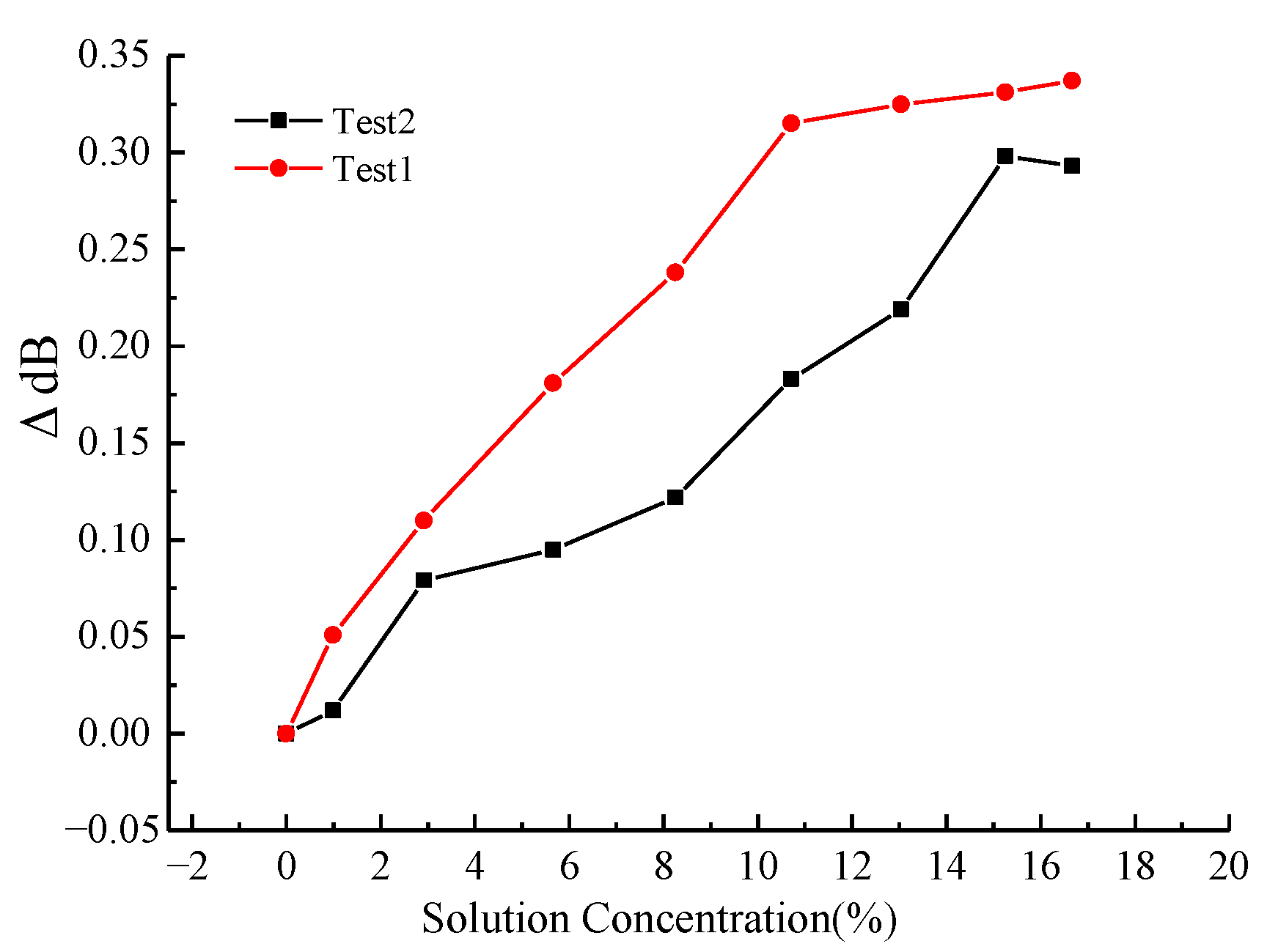
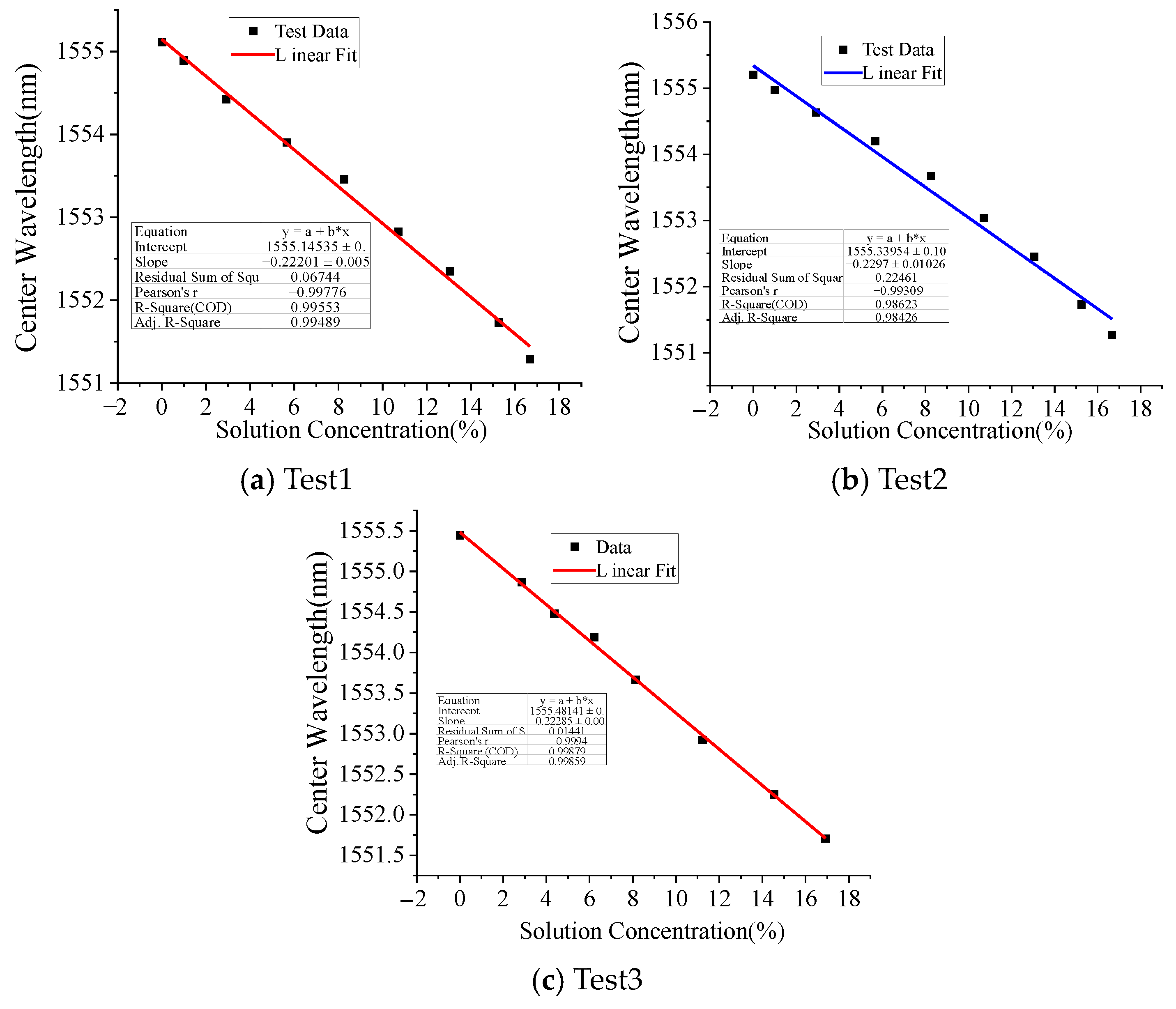
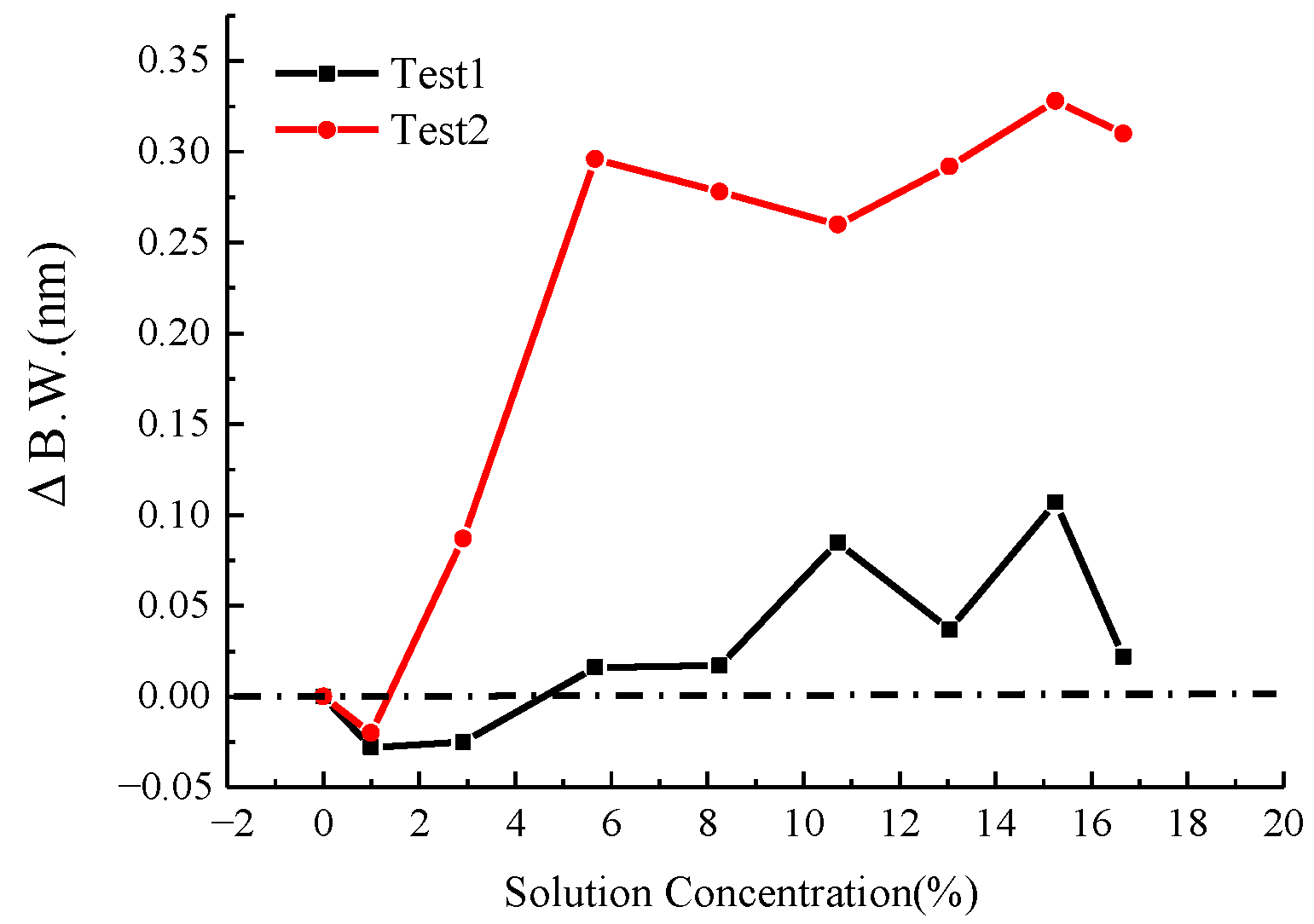
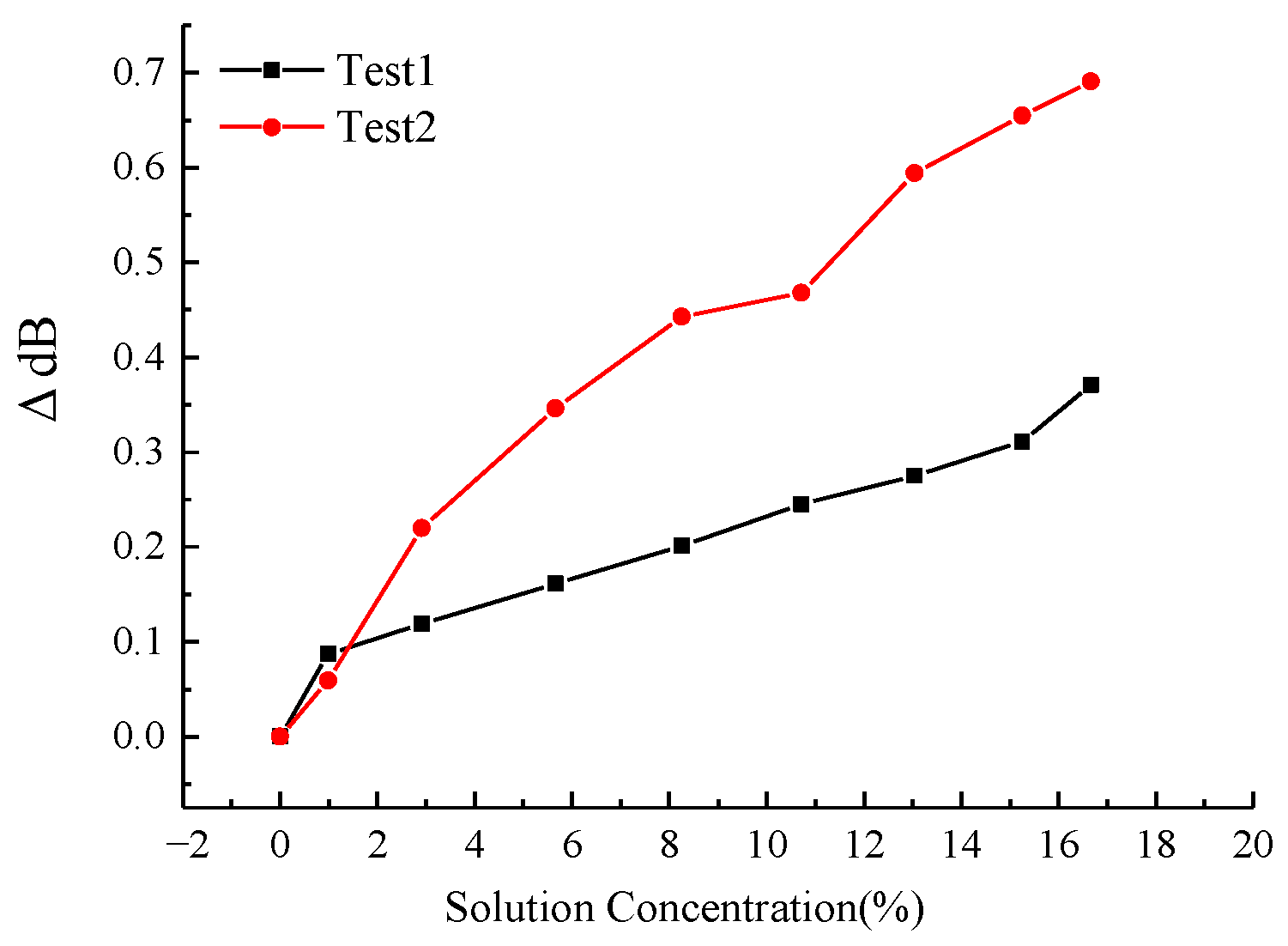

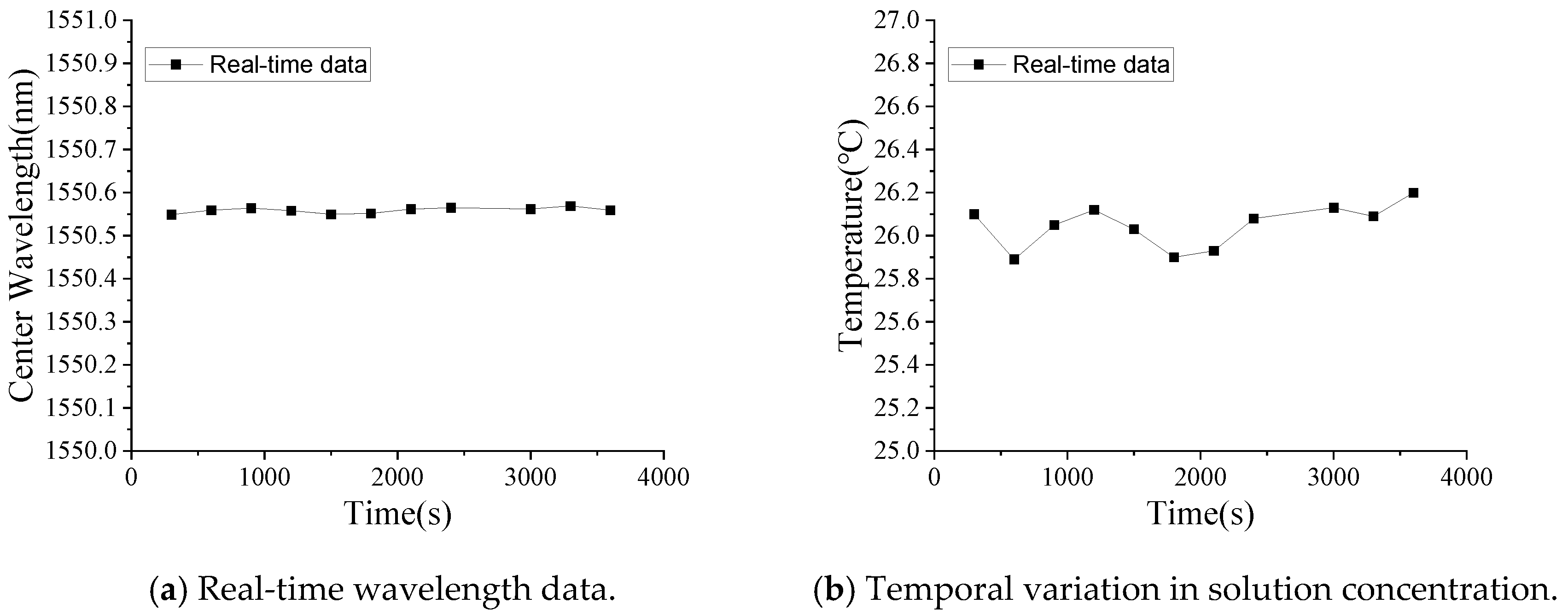
| NaCl Solution Concentration | CaCl2 Solution Concentration | |||||
|---|---|---|---|---|---|---|
| Test1 | Test2 | Test3 | Test1 | Test2 | Test3 | |
| Sensing coefficient (nm/%) | −0.160 | −0.157 | −0.163 | −0.222 | −0.230 | −0.223 |
| Residual sum of square | 0.01017 | 0.0865 | 0.00766 | 0.06744 | 0.22461 | 0.01441 |
| Pearson’s r | −0.99935 | −0.99428 | −0.99956 | −0.99776 | −0.99309 | −0.9994 |
| R-Square | 0.99869 | 0.98859 | 0.99912 | 0.99553 | 0.98623 | 0.99879 |
| Adj. R-Square | 0.99851 | 0.98697 | 0.99898 | 0.99489 | 0.98426 | 0.99859 |
Disclaimer/Publisher’s Note: The statements, opinions and data contained in all publications are solely those of the individual author(s) and contributor(s) and not of MDPI and/or the editor(s). MDPI and/or the editor(s) disclaim responsibility for any injury to people or property resulting from any ideas, methods, instructions or products referred to in the content. |
© 2025 by the authors. Licensee MDPI, Basel, Switzerland. This article is an open access article distributed under the terms and conditions of the Creative Commons Attribution (CC BY) license (https://creativecommons.org/licenses/by/4.0/).
Share and Cite
Zhang, Z.; Qin, T.; Bao, Y.; He, J. Development of LPFG-Based Seawater Concentration Monitoring Sensors Packaged by BFRP. Micromachines 2025, 16, 810. https://doi.org/10.3390/mi16070810
Zhang Z, Qin T, Bao Y, He J. Development of LPFG-Based Seawater Concentration Monitoring Sensors Packaged by BFRP. Micromachines. 2025; 16(7):810. https://doi.org/10.3390/mi16070810
Chicago/Turabian StyleZhang, Zhe, Tongchun Qin, Yuping Bao, and Jianping He. 2025. "Development of LPFG-Based Seawater Concentration Monitoring Sensors Packaged by BFRP" Micromachines 16, no. 7: 810. https://doi.org/10.3390/mi16070810
APA StyleZhang, Z., Qin, T., Bao, Y., & He, J. (2025). Development of LPFG-Based Seawater Concentration Monitoring Sensors Packaged by BFRP. Micromachines, 16(7), 810. https://doi.org/10.3390/mi16070810






